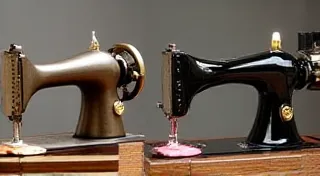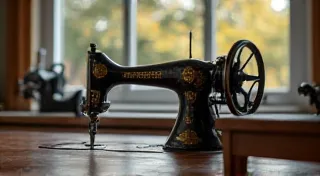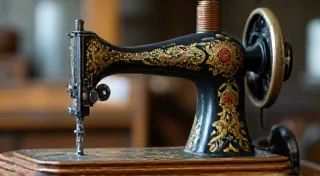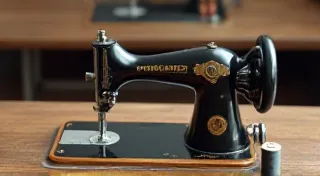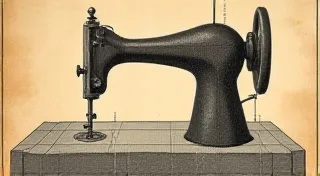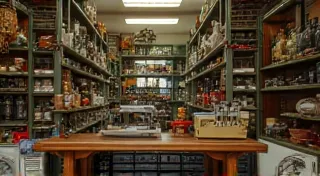The Evolution of the Treadle Sewing Machine: From Necessity to Collectible
The rhythmic clatter of a treadle sewing machine is a sound evocative of a bygone era – a time when clothing wasn't mass-produced and crafting was a vital skill. For collectors of vintage and antique sewing machines, the treadle represents a particularly fascinating chapter in sewing history. This article delves into the evolution of these iconic machines, exploring their development, common manufacturers, identification tips, and why they hold such value in the collecting world.
The Pre-Treadle Era: A Need for Speed
Before the advent of the treadle, hand-cranked sewing machines were the standard. While Elias Howe's 1846 patent revolutionized clothing production, the hand-cranking process was slow, laborious, and fatiguing. A need for a faster and less strenuous method of operation quickly became apparent, especially for professional seamstresses and dressmakers.
Early attempts to mechanize the process involved foot-powered mechanisms, but these were largely experimental and impractical. The concept of using the foot to power a sewing machine, however, planted the seed for a revolutionary development.
The Birth of the Treadle: Elias Howe Jr. and the First Models
Elias Howe Jr., the inventor of the sewing machine itself, is also credited with producing one of the earliest treadle sewing machines. Around 1851, Howe patented a treadle mechanism for his machines, though these early treadles were somewhat cumbersome and not always reliable. The design involved a complex system of levers and gears, often prone to breakage.
Other inventors quickly recognized the potential of foot-powered machines. The advantage was immediately clear: a skilled operator could sew much faster and for longer periods without significant fatigue. This led to a flurry of innovation and experimentation in the mid-1850s.

The Rise of the Manufacturers: Singer, Wilson, and Grover & Baker
Several companies seized upon the potential of the treadle and began producing their own versions. Among the most prominent were:
- Singer: Singer quickly recognized the potential of the treadle and introduced their first treadle machines in the mid-1850s. They became the dominant force in the sewing machine industry, constantly refining their designs and expanding their reach. Early Singer treadles often had a distinctive “walking foot” feature, which helped to feed the fabric more evenly.
- Wilson: Wilson Sewing Machine Company, founded by John H. Wilson, produced some of the most robust and well-regarded treadle machines. Their machines were known for their durability and quality of construction. Wilson treadles often had a more enclosed design.
- Grover & Baker: Grover & Baker became known for their high-quality, often ornate, treadle machines. They catered to a more upscale market and their machines were often used in professional tailoring shops.
- Domestic: The Domestic Sewing Machine Company, based in Europe, produced treadles that were frequently exported to the United States. Their machines stood out for their innovative features and sturdy construction.
These manufacturers, and others, constantly improved the design of the treadle, making it more efficient and user-friendly. The introduction of the oscillating treadle, which allowed for a more compact design and smoother operation, was a significant advancement.
Design Evolution & Features
Throughout the late 1800s and early 1900s, treadle sewing machine design evolved considerably. Early machines were often large and imposing, with a great deal of exposed mechanism. Later models incorporated more elegant cabinetry and enclosed components, making them more aesthetically pleasing. Common features that collectors look for include:
- Cabinet Design: Early treadles often had simple, functional cabinets. Later models featured elaborate carvings, inlays, and decorative hardware.
- Bobbins and Shuttle: Different manufacturers employed varying bobbin and shuttle designs, which can be a key identifier.
- Needle Bar Mechanism: The complexity and design of the needle bar mechanism can offer clues about the machine's age and manufacturer.
- Walking Foot: Some machines, particularly early Singers, featured a walking foot to aid in fabric feed.
- Belt Drive: The style and construction of the belt that connects the treadle to the flywheel can also be diagnostic.

Why Collect Treadle Sewing Machines?
Today, treadle sewing machines are highly prized by collectors for a variety of reasons:
- Historical Significance: They represent a pivotal moment in the history of manufacturing and technology.
- Engineering Marvel: The ingenious mechanisms and intricate construction are a testament to the ingenuity of 19th-century engineers.
- Aesthetic Appeal: The ornate cabinetry and classic styling make them beautiful objects in their own right.
- Practical Functionality: Many treadle machines are still in excellent working condition and can be used for sewing.
- Rarity and Value: Certain models, especially those in exceptional condition, can command significant prices.
Identification Tips for Collectors
Identifying a treadle sewing machine can be challenging, but several clues can help narrow down the search:
- Nameplates and Serial Numbers: Look for manufacturer’s nameplates and serial numbers, which can provide valuable information.
- Flywheel Design: The shape and markings on the flywheel are often unique to specific manufacturers.
- Cabinet Construction: The style and construction of the cabinet can offer clues about the machine's age and manufacturer.
- Internal Components: Examining internal components like the bobbin winder and needle bar can provide further identification.
- Reference Materials: Consult reference books and online resources dedicated to antique sewing machines.

Conclusion
The treadle sewing machine stands as a remarkable symbol of innovation and craftsmanship. From its origins as a solution to the drudgery of hand-cranked machines to its current status as a prized collectible, the treadle has a rich and fascinating history. For those interested in the history of sewing, technology, or simply beautiful antique objects, the treadle sewing machine offers a rewarding area of exploration.
